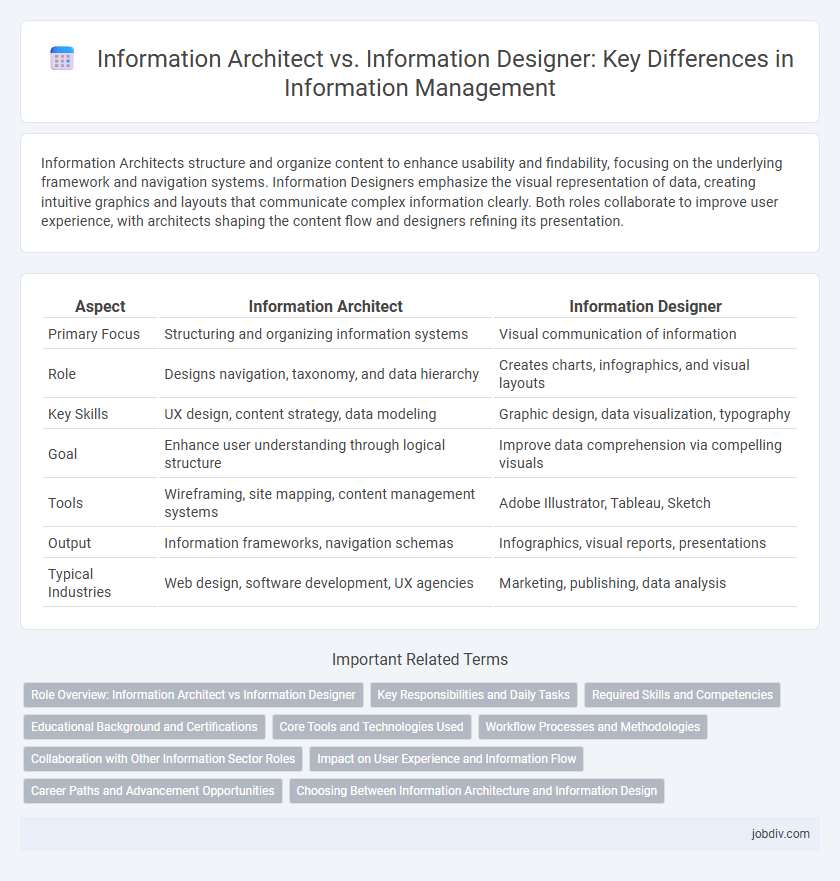Information Architects structure and organize content to enhance usability and findability, focusing on the underlying framework and navigation systems. Information Designers emphasize the visual representation of data, creating intuitive graphics and layouts that communicate complex information clearly. Both roles collaborate to improve user experience, with architects shaping the content flow and designers refining its presentation.
Table of Comparison
| Aspect | Information Architect | Information Designer |
|---|---|---|
| Primary Focus | Structuring and organizing information systems | Visual communication of information |
| Role | Designs navigation, taxonomy, and data hierarchy | Creates charts, infographics, and visual layouts |
| Key Skills | UX design, content strategy, data modeling | Graphic design, data visualization, typography |
| Goal | Enhance user understanding through logical structure | Improve data comprehension via compelling visuals |
| Tools | Wireframing, site mapping, content management systems | Adobe Illustrator, Tableau, Sketch |
| Output | Information frameworks, navigation schemas | Infographics, visual reports, presentations |
| Typical Industries | Web design, software development, UX agencies | Marketing, publishing, data analysis |
Role Overview: Information Architect vs Information Designer
Information Architects focus on structuring, organizing, and labeling digital content to enhance user navigation and ensure coherent information flow across platforms. Information Designers specialize in visually presenting data through infographics, charts, and diagrams, making complex information accessible and easily interpretable. Both roles play crucial parts in improving user experience but emphasize different aspects: architecture on strategic content framework, design on visual communication.
Key Responsibilities and Daily Tasks
Information Architects focus on structuring and organizing content to create intuitive navigation systems, defining taxonomies and user flows that enhance information findability. Information Designers concentrate on visually presenting data and content through wireframes, prototypes, and infographics to improve user comprehension and engagement. Both roles collaborate closely but diverge in their core tasks: architects map out the blueprint of information layout, while designers translate this structure into clear, accessible visual communication.
Required Skills and Competencies
Information Architects require strong skills in user experience (UX) design, content strategy, and metadata management to structure and organize information effectively. Information Designers focus on visual communication, requiring expertise in graphic design, data visualization, and storytelling to present information clearly and engagingly. Both roles demand analytical thinking, attention to detail, and proficiency with design and prototyping tools such as Axure, Sketch, or Adobe Creative Suite.
Educational Background and Certifications
Information Architects typically possess degrees in information science, computer science, or human-computer interaction, with certifications such as Certified Information Architect (CIA) enhancing their credentials. Information Designers often hold backgrounds in graphic design, communication, or multimedia arts, complemented by certifications like Adobe Certified Expert (ACE) focused on visual communication. Both roles benefit from continuing education in UX/UI principles, data visualization, and content strategy to refine their expertise.
Core Tools and Technologies Used
Information Architects primarily utilize tools such as wireframing software like Axure RP, flowchart applications like Microsoft Visio, and card sorting platforms including OptimalSort to structure and organize information systems. Information Designers focus on data visualization tools like Tableau, infographic software such as Adobe Illustrator, and prototyping tools like Sketch or Figma to create clear and compelling visual representations of information. Both roles leverage UX research platforms, content management systems, and analytics software to optimize user experience and data presentation.
Workflow Processes and Methodologies
Information Architects focus on structuring and organizing content through user research, wireframing, and taxonomy development to enhance information accessibility. Information Designers prioritize visual communication, employing data visualization, graphic design, and storytelling techniques to represent complex data clearly. Both roles utilize iterative workflows, with Information Architects emphasizing user-centric methodologies and Information Designers applying design thinking principles to optimize information delivery.
Collaboration with Other Information Sector Roles
Information architects collaborate closely with UX designers, content strategists, and data analysts to structure and organize information effectively, ensuring balanced user experience and accessibility. Information designers work alongside graphic designers, communicators, and software developers to visually represent data and complex concepts for better understanding and engagement. Both roles require seamless teamwork with web developers and digital marketers to integrate clear information flow across digital platforms, enhancing overall information delivery and usability.
Impact on User Experience and Information Flow
Information Architects structure and organize content to create clear navigation paths, enhancing user experience by enabling intuitive access to information. Information Designers focus on visually presenting data through effective layouts and graphics, improving information flow by making complex data easier to understand. Together, their roles optimize usability and comprehension in digital environments.
Career Paths and Advancement Opportunities
Information Architects focus on structuring and organizing data to enhance user experience, often advancing into roles like UX Director or Chief Information Officer. Information Designers specialize in visualizing complex information for clarity and impact, with career paths leading to Senior Visual Designer or Creative Director positions. Both fields offer opportunities in tech, media, and consultancy, emphasizing skills in data management, user research, and design tools for career growth.
Choosing Between Information Architecture and Information Design
Choosing between information architecture and information design depends on the project's goals: information architecture structures and organizes content for optimal navigation, while information design focuses on visualizing and presenting data clearly to enhance comprehension. Information architects develop taxonomies, navigation systems, and metadata frameworks that improve user experience by making information discoverable and accessible. Information designers create intuitive layouts, infographics, and interactive elements to communicate complex information effectively, prioritizing clarity and engagement.
Information Architect vs Information Designer Infographic

 jobdiv.com
jobdiv.com